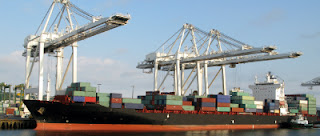Last Friday, we visited a New York Container Port located on the northwestern tip of Staten Island on Howland Hook, across the Arthur Kill from Elizabeth, NJ. The terminal occupies a 187-acre tract of upland area. The Port Authority of New York turned a brownfield site that was once operated by Proctor and Gamble (manufacturing Ivory soap), into the intermodal terminal it is today. This container port is one of five container ports in the New York/ New Jersey Area and it handles 20% of port traffic on daily basis. On any given day, 10,000 containers pass in and out of the port as imports and exports and these containers are approximately 20 feet long and 8 feet high (known as TEU or twenty-foot equivalent unit, an inexact measurement unit of cargo capacity based on the volume of the containers). According to the NYCT website, the port can handle 425,000 containers annually and can work and unload three vessels simultaneously with seven container cranes. The port is considerably import-driven, however the three main exports coming out of the port are recycled paper, scrap metal, and automobiles and their parts. The terminal is the largest employer in Staten Island and three different unions operate within the terminal.
The New York Container Port is operated by Global Container Terminals, Inc. which was established in 2007 as a fully owned subsidiary of the Ontario Teachers' Pension Plan, one of the largest financial institutions in Canada with over $87 billion in assets. The New York/New Jersey Port Authority has a long term lease agreement with Global Container Terminals who handle the business of the port. The port has its eyes on expansion, targeting an adjacent plot of land known as Port Ivory to provide the necessary area for expansion. However, there are obstacles to expansion such as an Environmental Impact Assessment that has declared the plan environmentally unsound and calls on the terminal to reassess its planning.
There is another obstacle, the Bayonne Bridge located on Kill Van Kull (the primary route to the region's largest shipping terminals) that must be raised or replaced to accommodate the next generation of gigantic container ships. At high tide, the bottom of the bridge is at about 151 feet above water and can accommodate most ships carrying 4000 and 5000 TEU. Often times, if these ships cannot fit at the tide circumstance, they must wait in the Kill Van Kull, incurring costs with long delays. There are already 100 or more ships around the globe that can handle 8,000 TEUs that are double the size of the ships already.
On the New York Container Terminals website, the Terminal boasts several logistical solutions that claim the effectiveness of the terminal. They are the harbor's only facility with on-site warehousing, also with on-site trucking capabilities. The NYCT is also located near the Goethals Bridge, which allows access to four major interstate highways. In addition to the major truck routes, the NYCT also operates a competitive on-dock rail service that connects to the North American intermodal rail service. The website applauds the efficiency and quick turn-around times at the port that allow businesses to run quicker and more efficiently. These logistics allow drivers on average, to move in and out of the terminal within 20 to 30 minutes.




No comments:
Post a Comment